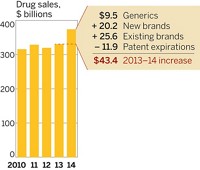Advertisement
Grab your lab coat. Let's get started
Welcome!
Welcome!
Create an account below to get 6 C&EN articles per month, receive newsletters and more - all free.
It seems this is your first time logging in online. Please enter the following information to continue.
As an ACS member you automatically get access to this site. All we need is few more details to create your reading experience.
Not you? Sign in with a different account.
Not you? Sign in with a different account.
ERROR 1
ERROR 1
ERROR 2
ERROR 2
ERROR 2
ERROR 2
ERROR 2
Password and Confirm password must match.
If you have an ACS member number, please enter it here so we can link this account to your membership. (optional)
ERROR 2
ACS values your privacy. By submitting your information, you are gaining access to C&EN and subscribing to our weekly newsletter. We use the information you provide to make your reading experience better, and we will never sell your data to third party members.
Business
Spending On Cancer Drugs Tops $100 Billion
Pharmaceuticals: Effectiveness of new drugs, longer duration of treatment drove up spending in 2014, IMS study finds
by Rick Mullin
May 7, 2015
Total global spending on oncology drugs has increased by an average 6.5% over the past five years, pushing the total in 2014 to more than $100 billion, according to a report published last week by the IMS Institute for Healthcare Informatics, the research arm of the health care data firm IMS Health.
The effectiveness of new cancer drugs, combined with early diagnosis, has led to longer duration of treatment, which has significantly increased global spending, according to the report, titled “Developments in Cancer Treatments, Market Dynamics, Patient Access and Value: Global Oncology Trend Report.”
IMS notes that targeted therapies—drugs designed to treat specific populations identified as receptive—are steadily increasing their share of the market, growing at an average of more than 14% annually for the past five years. The effect of the rising new drug prices, however, is unclear, according to Murray Aitken, executive director of the IMS Institute.
“It’s difficult to exactly disentangle price from volume,” Aitken says, “but what we can see is that in 2014, the largest contributor to growth in spending on cancer drugs came from the sales of newly launched drugs, followed by an increased volume of existing brands, and then price increases on brands.”
The increased spending may also be viewed as in indication that new drug treatments are contributing to improved health, Aitken says. Robert M. Goldberg, vice president of the Center for Medicine in the Public Interest, a health care policy research organization, agrees.
“I take it as a sign of progress, an indication of success in treating patients with drugs,” Goldberg says.




Join the conversation
Contact the reporter
Submit a Letter to the Editor for publication
Engage with us on Twitter